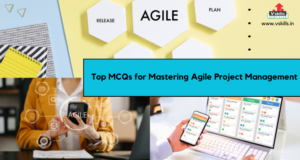Preparing for a project management role involves a combination of acquiring relevant skills, gaining practical experience, and developing a solid understanding of project management principles. Whether you are a seasoned professional looking to enhance your skills or a newcomer eager to embark on a fulfilling career, this blog series is designed to equip you with the knowledge and tools needed to excel in project management.
In today’s fast-paced business environment, effective project management is more critical than ever. It’s the key to bringing ideas to fruition, achieving organizational goals, and ensuring the successful delivery of projects on time and within budget. We will look into the essential aspects of project management, offering insights, practical tips, and strategies to help you navigate the complexities of leading successful projects.
Navigating the Project Management Landscape
In the complex landscape of project management, success is not merely a result but a journey marked by planning, adept leadership, and a strategic approach to challenges. The role of a project manager is dynamic and multifaceted, with opportunities spanning various industries and sectors. Here’s a closer look at the job roles and opportunities available for project managers:
- Project Manager: The primary role involves overseeing the entire project life cycle, from initiation to closure. Project managers are responsible for planning, executing, monitoring, controlling, and closing projects within specified constraints.
- Program Manager: Program managers handle multiple projects that are often interrelated. They ensure that individual projects align with the overall program goals and organizational objectives.
- Portfolio Manager: Portfolio managers manage a collection of projects and programs, aligning them with the organization’s strategic goals. They prioritize projects based on their contribution to overall success.
- Agile Project Manager: In an Agile environment, project managers may take on the role of facilitating Agile processes, ensuring collaboration among team members, and removing impediments to progress.
- Scrum Master: In Scrum methodology, the Scrum Master serves as a facilitator, ensuring that the Scrum team adheres to Agile principles and follows the Scrum framework.
- Product Manager: Product managers focus on the development and delivery of a specific product. They work closely with cross-functional teams to ensure that the product meets customer needs and business objectives.
- Construction Project Manager: In the construction industry, project managers oversee building projects from planning and design to construction and completion. They coordinate with architects, engineers, and contractors to ensure successful project delivery.
- IT Project Manager: IT project managers handle projects related to software development, system upgrades, and technology implementations. They collaborate with developers, analysts, and stakeholders to ensure project success.
- Healthcare Project Manager: In healthcare, project managers may lead initiatives such as implementing new healthcare systems, managing process improvements, or overseeing the construction of medical facilities.
- Event Project Manager: Event project managers coordinate and execute events, conferences, and exhibitions. They handle logistics, budgets, and timelines to ensure the successful execution of events.
The versatility of project management roles and the widespread demand for skilled professionals make it a rewarding and dynamic career path. Whether you aspire to lead IT projects, construction initiatives, or strategic programs, a career in project management offers a wealth of opportunities for growth and impact.
Embracing Change and Innovation
In the ever-evolving landscape of project management, change is inevitable. Equip yourself with strategies to adapt, innovate, and steer your projects toward success despite unexpected twists and turns.
As we embark on this comprehensive exploration together, our commitment is to provide you with not just theoretical knowledge but actionable insights that you can apply in the real world. Stay tuned for a wealth of information, tips, and strategies designed to empower you on your journey to mastering the art of project management. Let’s navigate the complexities and build a foundation for lasting project success!
Interview Questions and Answers
1. What is the Project Management Triangle, and how does it apply to project management?
A. It represents the three most common project shapes.
B. It illustrates the relationship between project management, program management, and portfolio management.
C. It represents the interdependence of scope, time, and cost in project management.
D. It is a symbol for the three main project management methodologies.
Answer: C. It represents the interdependence of scope, time, and cost in project management.
2. Which of the following is typically included in a Project Initiation Document (PID)?
A. Detailed project schedule
B. Risk management plan
C. List of project stakeholders
D. Project closure report
Answer: C. List of project stakeholders.
3. What is a Work Breakdown Structure (WBS)?
A. A document outlining work hours for the project.
B. A hierarchical breakdown of project tasks.
C. A list of project risks.
D. A schedule of project milestones.
Answer: B. A hierarchical breakdown of project tasks.
4. Which project management methodology is known for its iterative and adaptive approach?
A. Waterfall
B. Agile
C. Scrum
D. Lean
Answer: B. Agile.
5. What is the critical path method (CPM) used for?
A. To identify the shortest path in a project schedule.
B. To determine the most critical project stakeholders.
C. To calculate the project’s budget.
D. To identify the longest path in a project schedule and determine project duration.
Answer: D. To identify the longest path in a project schedule and determine project duration.
6. What is a Project Charter used for?
A. Documenting the history of the project.
B. Formally authorizing a project and providing project details.
C. Recording the minutes of project meetings.
D. Creating a visual representation of the project schedule.
Answer: B. formally authorizing a project and providing project details.
7. How should project scope changes be handled?
A. Ignored to maintain project stability.
B. Documented, evaluated for impact, and approved by relevant stakeholders.
C. Implemented without notifying stakeholders to save time.
D. Delayed until the project is completed.
Answer: B. Documented, evaluated for impact, and approved by relevant stakeholders.
8. What is earned value management (EVM) used for?
A. Managing stakeholder expectations.
B. Calculating project risk.
C. Integrating project scope, schedule, and cost to assess project performance.
D. Prioritizing project tasks.
Answer: C. Integrating project scope, schedule, and cost to assess project performance.
9. What is the primary purpose of stakeholder analysis in project management?
A. To create a list of potential project team members.
B. To assess the technical aspects of the project.
C. To identify, assess, and engage stakeholders to understand their interests, influence, and needs.
D. To define the project’s schedule.
Answer: C. To identify, assess, and engage stakeholders to understand their interests, influence, and needs.
10. What is the primary role of a Project Manager in a project?
A. Technical expert
B. Resource allocator
C. Decision-maker
D. Stakeholder
Answer: B. Resource allocator.
11. Which project management document defines how the project will be executed, monitored, and controlled?
A. Project Charter
B. Project Schedule
C. Project Scope Statement
D. Project Management Plan
Answer: D. Project Management Plan.
12. What is the purpose of a Gantt chart in project management?
A. To track project budget
B. To manage project risks
C. To visualize project schedule and tasks
D. To analyse stakeholder engagement
Answer: C. To visualize project schedule and tasks.
13. What does the acronym RACI stand for in the context of project management?
A. Resource Allocation Control and Implementation
B. Roles, Assignments, Communication, and Instructions
C. Responsible, Accountable, Consulted, Informed
D. Risk Assessment and Control Items
Answer: C. Responsible, Accountable, Consulted, Informed.
14. Which project management phase involves formally completing the project work and obtaining customer or stakeholder acceptance?
A. Initiation
B. Planning
C. Execution
D. Closing
Answer: D. Closing.
15. What is the purpose of a change control board in project management?
A. To approve project budget changes
B. To review and approve or reject project scope changes
C. To manage project team communication
D. To create project schedules
Answer: B. To review and approve or reject project scope changes.
16. What is the purpose of a Lessons Learned document in project management?
A. To list all the mistakes made during the project
B. To evaluate the performance of individual team members
C. To capture knowledge gained and mistakes made for future reference
D. To document the project closure process
Answer: C. To capture knowledge gained and mistakes made for future reference.
17. In the context of project quality management, what is the definition of quality control?
A. Ensuring that the project is completed on time
B. Making sure the project stays within budget
C. Monitoring and verifying that project deliverables meet specified quality standards
D. Managing project stakeholder expectations
Answer: C. Monitoring and verifying that project deliverables meet specified quality standards.
18. What is the purpose of a stakeholder register in project management?
A. To record the names of all team members
B. To identify project risks
C. To document information about project stakeholders, including their interests, expectations, and influence
D. To track project schedule changes
Answer: C. To document information about project stakeholders, including their interests, expectations, and influence.
19. Which of the following is not a component of the project closing process?
A. Handover of project deliverables
B. Post-project review and evaluation
C. Archiving project documentation
D. Initial project planning
Answer: D. Initial project planning.
20. What is the key difference between a project and a program?
A. Projects are long-term, while programs are short-term.
B. Projects are collections of related tasks, while programs are focused on a single objective. C. Projects are temporary endeavours, while programs are collections of related projects.
D. Projects have a broad scope, while programs have a narrow focus.
Answer: C. Projects are temporary endeavours, while programs are collections of related projects.




